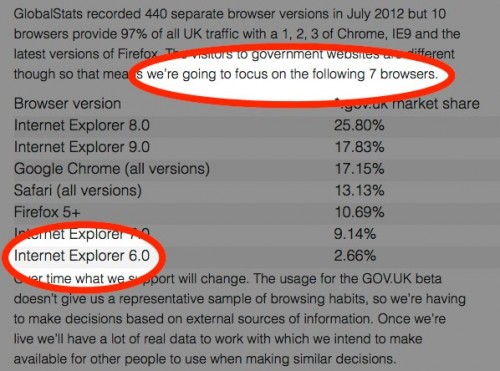In a post on the (then) Alphagov blog in April last year about design principles:
Given it has 3.5% UK market share and Microsoft are trying to persuade everyone to shift off it, we assumed IE6 is dead (actually, we were a tad ruder than that).
The blog post was illustrated by a photograph showing design principles scribbled on cards, and stuck around the room (which was in the old COI headquarters of Hercules House). See that ‘IE6’ one disappearing off the top? There’s a very good reason why the photo is cropped precisely there. Clue: four letters, begins with F.


I think this is a well-intentioned mistake. Gov.uk is a clean slate, a rare opportunity to force people to upgrade, for their own good. GDS is a future-oriented operation, charged with leading a revolution in the delivery of public services. Oh – and cutting costs, too. Ask any web developer about the cost, in terms of both person hours and opportunity cost, of supporting IE6.
This effective endorsement of the continued use of an 11 year old browser is entirely contradictory to that mission. Sure, they’d take some flak for it. But it would be an opportunity to promote the message of ‘Government’s preferred online security advice channel’, GetSafeOnline, which states quite categorically: ‘Always ensure that you are running the latest version of your chosen browser.’
Responses
This possibly has more to do with the fact that if Gov.uk didn’t support IE6 then staff in some (many?) government departments won’t be able to browse the website.
Have written about this in numerous places but one issue – that my company helped by going along with insane user requirements at the time – is with how IE6 used to allow embedded MS objects, e.g. MS Word and Excel – a feature dropped at IE7 as it was a Pandora’s Box for vulnerabilities – and that some older intranet systems were built around this feature. Including one I built – but only because “they made me do it!”
To be honest these systems do still work on later browsers but the embedded objects open the tools (Excel etc) in separate windows. But on paper the system vendors say “supported browsers: IE6” and this is then taken as gospel.
Disclaimer: it’s now getting on 2 years since I spoke to an actual gov department still stuck on IE6 so I can’t say for sure whether this hasn’t now solved itself in some way..
Feel the pain – I hate IE6 (and 8) too – but govt sites should not exclude users, especially when there is pressure to reach hard to get groups. From dealing with technophobes using the web, I can say that many are fearful of upgrading anything.
Hi Simon,
What we haven’t made clear in the that blog post is to what extent we will ‘support’ IE6. We expect IE6 to be usable (i.e. you can see the content), but it doesn’t have to look good.
We will be keeping our list of ‘supported’ browsers under regular review, especially as the the use of IE6 is plummeting quickly.
Dafydd
As some have commented its other government deployments themselves that are the “problem”. I just checked some stats on a big govt site I work on
General usage on IE6 = 5% (higher than the 2.66)
Use of IE6 on a specific bit of content for Govt Stakeholders was 25% !!
Also as mentioned there is a difference between, designing for IE6 and Supporting IE6 and simply telling large pockets of govt to update would not be practical or even cost effective.
This is not a great situation I agree, but its the reality.
Just checked the GOV.UK stats for yesterday. 2.8% of the visitors were using IE6.